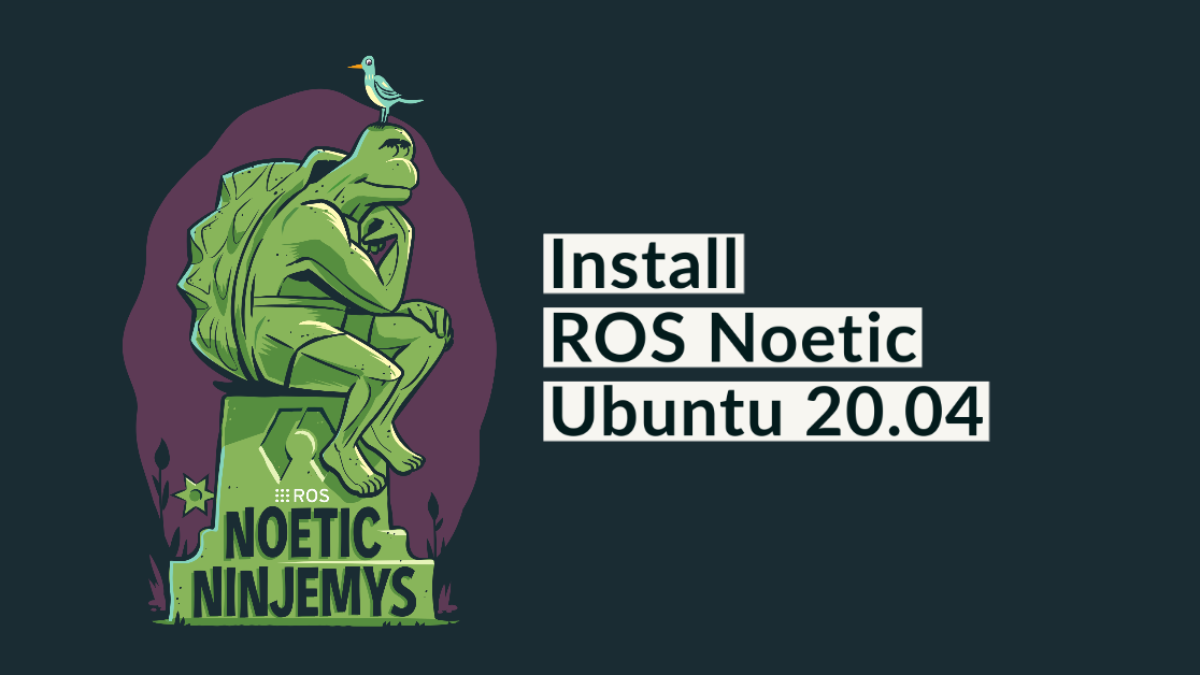Pre-requisite Software
Note
All the ROS related software should be installed/run on remote PC/Rasberry Pi/Nvidia board, nothing needed to be installed on robots control board if bought with the ROS pkg.
[Ubuntu 20.04 - ROS NOETIC]

The ROS driver for the robots is initially supported for the
ROS Noetic. All of ROS related software should be installed in a Remote-PC. The
steps for shown below are for Remote-PC or GO1-PC.
Warning
Care should be taken when installing ROS so that it matches with your CPU’s architecture (i.e. armhf, amd64, arm6, etc.)
PC Setup
ROS Noetic installation requires Ubutnu 20.04.
Download Ubuntu 20.04
Follow the Ubuntu 20.04 Installation guide
ROS-noetic Installation
The ros driver provided can be run either on a remote PC or on board robot computer. Usually, the on-board computer already has pre-installed ROS distribution, so the instructions below will be applicable to a remote computer. You may run the following commands to install ROS noetic or you can simply follow the instructions from the roswiki.
Enter the Ubuntu terminal and typie in the following command:
cd
The next step is setting up the source list:
sudo sh -c 'echo "deb http://packages.ros.org/ros/ubuntu $(lsb_release -sc) main" > /etc/apt/sources.list.d/ros-latest.list'
After which you will set up the keys:
sudo apt install curl
curl -s https://raw.githubusercontent.com/ros/rosdistro/master/ros.asc | sudo apt-key add -
Then, you will install ROS-noetic:
sudo apt update
sudo apt install ros-noetic-desktop-full
Finally, you will add ROS environment to your bash file, what this means is that each time you load up your terminal, it will automatically find the built-in ROS packages.
echo "source /opt/ros/noetic/setup.bash" >> ~/.bashrc
source ~/.bashrc
Install python dependencies and initialize repo:
sudo apt install python3-rosdep python3-rosinstall python3-rosinstall-generator python3-wstool build-essential
sudo rosdep init
rosdep update
Once the ROS packages are set-up the next step would be to set up a workspace in which you can add pre-built packages to control your robot.
Catkin Workspace
The first step is to ensure that you have correctly setup you ROS noetic. It can be checked by:
cd ..
source /opt/ros/noetic/setup.bash
Next, install catkin_tools:
sudo apt install python3-catkin-tools
The next step is to create, your workspace. This is typically created in the home directory following the standard ROS convention, once built, you should see a
buildanddevelfolder next to yoursrcfolder:
mkdir -p ~/catkin_ws/src
cd ~/catkin_ws/
catkin build
To enable the workspace, you must type in:
source devel/setup.bash
To avoid typing this everytime you start a terminal, you’ll add this into the
last lineof the bashrc file:
gedit ~/.bashrc
Add the following line at the end of the bashrc file:
source /home/<your_computer_username>/catkin_ws/devel/setup.bash
Everytime you do a
catkin build, it is necessary to either restart all your terminals, or source them.To verify that everything is working correctly, type the following into the terminal:
echo $ROS_PACKAGE_PATH
[Ubuntu 18.04 - ROS MELODIC]

The ROS driver for the robots is initially supported for the
ROS Melodic. All of ROS related software should be installed in a
remote PC/Rasberry Pi/Nvidia board that is onboard the robot. The robot
ships either with Rasberry Pi or Nvidia board as an upgradation kit. The
steps for shown below are for remote PC both boards usually come with
pre-installed ROS distribution.
Note: All the ROS related software should be installed/run on remote PC/Rasberry Pi/Nvidia board, nothing needs to be installed on robots control board.
PC Setup
ROS Melodic installation requires Ubutnu 18.04 Bionic, Artful and supports macOS, Windows upto varying extent. But for this installation Ubuntu 18.04.x Bionic is recommended.
ROS-Melodic Installation
The ros driver provided can be run either on a remote PC or on board robot computer. Therefore, ROS only needs to be installed on any one of them. Usually, the on board computer have already pre-installed ROS distribution, so below one will only be applicable to a remote computer. Run following commands to install ROS Melodic or you can simply follow the instructions.
Enter the Ubuntu terminal and typie in the following command:
cd ..
The next step is setting up the source list:
sudo sh -c 'echo "deb http://packages.ros.org/ros/ubuntu $(lsb_release -sc) main" > /etc/apt/sources.list.d/ros-latest.list'
After which you will set up the keys:
sudo apt install curl
curl -s https://raw.githubusercontent.com/ros/rosdistro/master/ros.asc | sudo apt-key add -
Then, you will install ROS-melodic:
sudo apt update
sudo apt install ros-melodic-desktop-full
Finally, you will add ROS environment to your bash file, what this means is that each time you load up your terminal, it will automatically find the built-in ROS packages.
echo "source /opt/ros/melodic/setup.bash" >> ~/.bashrc
source ~/.bashrc
Once the ROS packages are set-up the next step would be to set up a workspace in which you can add pre-built packages to control your robot.
Catkin Workspace
The first step is to ensure that you have correctly setup you ROS melodic. It can be checked by:
cd ..
source /opt/ros/melodic/setup.bash
Next, install catkin_tools:
sudo apt-get install python3-catkin-tools
The next step is to create, your workspace. This is typically created in the home directory following the standard ROS convention, once built, you should see a
buildanddevelfolder next to yoursrcfolder:
mkdir -p ~/catkin_ws/src
cd ~/catkin_ws/
catkin build
To enable the workspace, you must type in:
source devel/setup.bash
To avoid typing this everytime you start a terminal, you’ll add this into the
last lineof the bashrc file:
gedit ~/.bashrc
Add the following line at the end of the bashrc file:
source devel/setup.bash
Everytime you do a Catkin build it is necessary to either restart all your terminals, or source them.
To verify that everything is working correctly, type the following into the terminal:
echo $ROS_PACKAGE_PATH